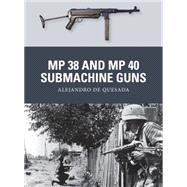Nazi Germany's MP 38 and MP 40 submachine guns are among World War II's most iconic weapons, but it is often forgotten that they continued in use all over the world for many decades after 1945, even being seen during the fighting in Libya in 2011. Widely issued to Fallschirmjäger (parachute infantry) owing to their portability and folding stocks, the MP 38 and MP 40 became the hallmarks of Germany's infantry section and platoon leaders; by the war's end the Germans were following the Soviet practice of issuing entire assault platoons with submachine guns. Over 1 million were produced during World War II, many finding their way after 1945 into the hands of paramilitary and irregular forces, from Israel to Vietnam; the Norwegian armed forces continued to use them until the early 1990s, and examples and derivatives saw widespread use in the Yugoslav wars of that decade.
The submachine-gun concept had its origins in the trenches of World War I, as German designers sought to develop a new weapon that utilized pistol ammunition to deliver devastating bursts of automatic fire at close ranges. The massively influential Bergmann MP 18, the world's first purpose-built 'machine pistol' (submachine gun), spearheaded the German assaults of 1918 and, although the Treaty of Versailles banned the study and manufacture of light automatic weapons in Germany, weapons designers like Berthold Geipel and Heinrich Vollmer of Erfurter Maschinenfabrik (Erma) covertly continued to innovate in this field.
An open-bolt, blowback-operated weapon with a single-feed 32-round magazine offering fully automatic fire only and a patented telescoping return spring guide that served as a pneumatic recoil buffer, Geipel and Vollmer's MP 38 drew upon earlier prototypes such as the VMP 1930 and MP 36, as well as the EMP 35, another Erma design that was widely exported and saw combat in the Spanish Civil War. The MP 38 was one of the first of the lighter, more compact "second generation" of submachine guns, utilizing stamped-steel and plastic components that made it easier to produce than earlier types such as the M1928 Thompson and the MP 18, which featured wooden stocks and employed machined-steel parts. It was rapidly adopted by Germany's armed forces and first saw combat during the invasion of Poland in 1939. An improved version, the MP 40, made greater use of stamped steel and electro-spot welding to simplify production further; a twin-magazine version, the MP 40/II, was briefly and unsuccessfully considered as a counter to the select-fire Soviet PPSh-41 with its 71-round drum magazine.
The MP 38 and the MP 40 saw combat in the hands of German troops in every theater in which they were involved, and have become synonymous with Nazi Germany's war effort in popular perception. Even during the war Geipel and Vollmer's designs, mistakenly attributed to the rival designer Hugo Schmeisser by the Allies, profoundly influenced the British Sten and the US M3 "grease gun" as well as postwar weapons such as the Spanish Star Modelo Z-45 and the Yugoslav M56. Featuring specially commissioned full-color artwork and period and close-up photographs, this is the story of the origins, combat use, and lasting influence of two of World War II's most famous firearms.








